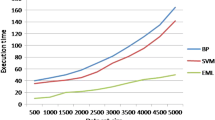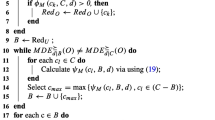Abstract
The existence of both uncertainty and imprecision has detrimental impact on efficiency of decision-making applications and some machine learning methods, in particular support vector machine in which noisy samples diminish the performance of SVM training. Therefore, it is important to introduce a special method in order to improve this problem. Fuzzy aspects can handle mentioned problem which has been considered in some classification methods. This paper presents a novel weighted support vector machine to improve the noisy sensitivity problem of standard support vector machine for multiclass data classification. The basic idea is considered to add a weighted coefficient to the penalty term Lagrangian formula for optimization problem, which is called entropy degree, using lower and upper approximation for membership function in fuzzy rough set theory. As a result, noisy samples have low degree and important samples have high degree. To evaluate the power of the proposed method WSVM-FRS (Weighted SVM-Fuzzy Rough Set), several experiments have been conducted based on tenfold cross-validation over real-world data sets from UCI repository and MNIST data set. Experimental results show that the proposed method is superior than the other state-of-the-art competing methods regarding accuracy, precision and recall metrics.








Similar content being viewed by others
References
Alcantud JCR, Díaz S, Montes S (2019) Liberalism and dictatorship in the problem of fuzzy classification. Int J Approx Reason 110:82–95
Bian H, Mazlack L (2003) Fuzzy-rough nearest-neighbor classification approach. In: IEEE 22nd international conference of the North American Fuzzy Information Processing Society, pp 500–505
Chang CC, Lin CJ (2011) Libsvm: a library for support vector machines. ACM Trans Intell Syst Technol (TIST) 2(3):27
Changdar C, Pal RK, Mahapatra GS (2016) A genetic ant colony optimization based algorithm for solid multiple travelling salesmen problem in fuzzy rough environment. Soft Comput 21:1–15
Chen D, Yang W, Li F (2008) Measures of general fuzzy rough sets on a probabilistic space. Inf Sci 178:3177–3187
Cohen S Afshar JT, van Schaik A (2017) Emnist: an extension of mnist to handwritten letters. arXiv preprint http://arxiv.org/abs/1702.05373
Cortes C, Vapnik V (1995) Support-vector networks. Mach Learn 20(3):273–297
Demsar J (2006) Statistical comparisons of classifiers over multiple data sets. J Mach Learn Res 7:1–30
Derrac J, Verbiest N, García S, Cornelis C, Herrera F (2013) On the use of evolutionary feature selection for improving fuzzy rough set based prototype selection. Soft Comput 17:223–238
Ding S, Zhang X, An Y, Xue Y (2017) Weighted linear loss multiple birth support vector machine based on information granulation for multi-class classification. Pattern Recognit 67:32–46
Du W, Cao Z, Song T, Li Y, Liang Y (2017) A feature selection method based on multiple kernel learning with expression profiles of different types. BioData Min 10:1–16
Dubois D, Prade H (1990) Rough fuzzy sets and fuzzy rough sets. Int J Gen Syst 17:191–209
Hamidzadeh J, Ghadamyari R (2019) Clustering data stream with uncertainty using belief function theory and fading function. Soft Comput 24:127–138
Hamidzadeh J, Moradi M (2018) Improved one-class classification using filled function. Appl Intell 48:1–17
Hamidzadeh J, Moradi M (2020) Enhancing data analysis: uncertainty-resistance method for handling incomplete data. Appl Intell 50:74–86
Hamidzadeh J, Namaei N (2018) Belief-based chaotic algorithm for support vector data description. Soft Comput 23:1–26
Hamidzadeh J, Monsefi R, Yazdi HS (2014) LMIRA: large margin instance reduction algorithm. Neurocomputing 145:477–487
Hamidzadeh J, Sadeghi R, Namaei N (2017) Weighted support vector data description based on Chaotic bat algorithm. Appl Soft Comput 60:540–551
Han D, Liu W, Dezert J, Yang Y (2016) A novel approach to pre-extracting support vectors based on the theory of belief functions. Knowl Based Syst 110:210–223
Hsu CW, Lin CJ (2002) A comparison of methods for multi-class support vector machines. IEEE Trans Neural Netw 13:415–425
Javid M, Hamidzadeh J (2019) An active multi-class classification using privileged information and belief function. Int J Mach Learn Cybern 11:1–14
Karal O (2017) Maximum likelihood optimal and robust Support Vector Regression with lncosh loss function. Neural Netw 94:1–12
LeCun Y, Cortes C, Burges CJC (2010) The MNIST database of handwritten digits. http://yann.lecun.com/exdb/mnist
Li J, Wang Y, Cao Y, Xu C (2016) Weighted doubly regularized support vector machine and its application to microarray classification with noise. Neurocomputing 173:595–605
Li J, Wang J, Zheng Y, Xiao H (2017) Microarray classification with noise via weighted adaptive elastic net. In: IEEE data driven control and learning systems, pp 26–27
Lichman M (2013) UCI machine learning repository. http://archive.ics.uci.edu/ml.
Liu Z, Dezert J, Pan Q, Mercier G (2011) Combination of sources of evidence with different discounting factors based on a new dissimilarity measure. Decis Support Syst 52:133–141
Liu Z, Pan Q, Dezert J, Mercier G (2015) Credal c-means clustering method based on belief functions. Knowl Based Syst 74:119–132
Liu Z, Pan Q, Dezert J, Martin A (2016) Adaptive imputation of missing values for incomplete pattern classification. Pattern Recognit 52:85–957
Lu X, Liu W, Zhou C, Huang M (2017) Probabilistic weighted support vector machine for robust modeling with application to hydraulic actuator. IEEE Trans Ind Inform 13(4):1723–1733
Ma J, Zhou S, Li. Chen, W. Wang, Z. Zhang, (2019) A sparse robust model for large scale multi-class classification based on K-SVCR. Pattern Recognit Lett 117:16–23
Mao WT, Xu JC, Wang C et al (2014) A fast and robust model selection algorithm for multi-input multi-output support vector machine. Neurocomputing 130:10–19
Moghaddam VH, Hamidzadeh J (2016) New Hermite orthogonal polynomial kernel and combined kernels in Support Vector Machine classifier. Pattern Recognit 60:921–935
Nguyen VL, Desterck S, Masson MH (2018) Partial data querying through racing algorithms. Int J Approx Reason 96:36–55
Pawlak Z (1982) Rough sets. Int J Comput Inf Sci 11:341–356
Santhanama V, Morariua VI, Harwooda D, Davisa LS (2016) A non-parametric approach to extending generic binary classifiers for multi-classification. Pattern Recogn 58:149–158
Shafer G (1976) A mathematical theory of evidence. Princeton University Press
Sheng H, Xiao J, Wang Z, Li F (2015) Electric vehicle state of charge estimation: nonlinear correlation and fuzzy support vector machine. J Power Sources 281:131–137
Singh S, Shreevastava S, Som T, Somani G (2020) A fuzzy similarity-based rough set approach for attribute selection in set-valued information systems. Soft Comput 24:4675–4691
Sivasankar E, Selvi C, Mahalakshmi S (2020) Rough set-based feature selection for credit risk prediction using weight-adjusted boosting ensemble method. Soft Comput 24:3975–3988
Sun W, Liu C, Xu Y, Tian L, Li W (2017) A band-weighted support vector machine method for hyperspectral imagery classification. IEEE Geosci Remote Sens Soc 14:1710–1714
Tang H, Dong P, Shi Y (2019) A new approach of integrating piecewise linear representation and weighted support vector machine for forecasting stock turning points. Appl Soft Comput 78:685–696
Vanir V (1999) An overview of statistical learning theory. IEEE Trans Neural Netw 10(5):988–999
Vapnik V (1995) The nature of statistical learning theory. IEEE Trans Neural Netw 10(5):988–999
Verbiest N, Cornelis C, Herrera F (2013a) FRPS: a fuzzy rough prototype selection method. Pattern Recognit 46:2770–2782
Verbiest N, Cornelis C, Herrera F (2013b) FRPS: a fuzzy rough prototype selection method. Pattern Recognit 46(10):2770–2782
Wu WZ, Leung Y, Zhang WX (2002) Connections between rough set theory and Dempster–Shafer theory of evidence. Int J Gen Syst 31:405–430
Xu Q, Zhang J, Jiang C, Huang X, He Y (2015) Weighted quantile regression via support vector machine. Expert Syst Appl 42:5441–5451
Xu P, Davoine F, Zha H, Denœuxa T (2016) Evidential calibration of binary SVM classifiers. Int J Approx Reason 72:55–70
Xue Y, Zhang L, Wang B, Zhang Z, Li F (2018) Nonlinear feature selection using Gaussian kernel SVM-RFE for fault diagnosis. Appl Intell 48:1–26
Yang L, Xu Z (2017) Feature extraction by PCA and diagnosis of breast tumors using SVM with DE-based parameter tuning. Int J Mach Learn Cyber 10:1–11
Yang X, Song Q, Cao A (2005) Weighted support vector machine for data classification. IEEE Int Joint Conf Neural Netw 2:859–864
Yang X, Tan L, He L (2014) A robust least squares support vector machine for regression and classification with noise. Neurocomputing 140:41–52
Yao Y, Lingras P (1998) Interpretations of belief functions in the theory of rough sets. Inf Sci 104:81–106
Zadeh LA (1965) Fuzzy sets. Inf Control 8:338–353
Zhai J (2011) Fuzzy decision tree based on fuzzy-rough technique. Soft Comput 15:1087–1096
Zhang W, Yu L, Yoshida T, Wang Q (2018) Feature weighted confidence to incorporate prior knowledge into support vector machines for classification. Knowl Inf Syst 58:1–27
Zhou C, Lu X, Huang M (2016) Dempster–Shafer theory-based robust least squares support vector machine for stochastic modelling. Neurocomputing 182:145–153
Zhu X, Wu X (2004) Class noise vs. attribute noise: a quantitative study of their impacts. Artif Intell Rev 22:177–210
Author information
Authors and Affiliations
Corresponding author
Ethics declarations
Conflict of interest
The authors declare that they have no conflict of interest.
Ethical approval
This article does not contain any studies with animals performed by any of the authors.
Additional information
Publisher's Note
Springer Nature remains neutral with regard to jurisdictional claims in published maps and institutional affiliations.
Rights and permissions
About this article
Cite this article
Moslemnejad, S., Hamidzadeh, J. Weighted support vector machine using fuzzy rough set theory. Soft Comput 25, 8461–8481 (2021). https://doi.org/10.1007/s00500-021-05773-7
Accepted:
Published:
Issue Date:
DOI: https://doi.org/10.1007/s00500-021-05773-7




